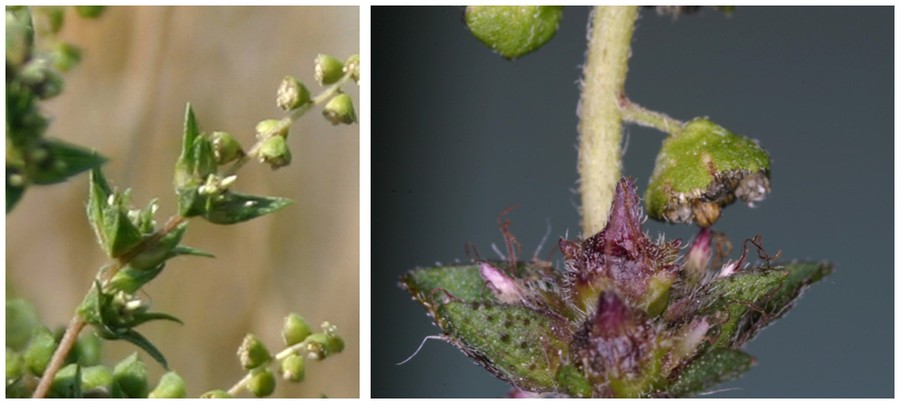Common mullein’s Other Adaptations to Tough Situations
• Its thick fleshy taproot sometimes branches into a shallow secondary fibrous root system. It can dig 1’ down to withstand drought.
• It vectors enough blights to damage competitive Cotton and vegetable crops.
• It competes well in sparsely vegetated limy, rocky, gravelly pits, barren wind-swept areas, and in poor soil. In overgrazed land, after a fire, after repeated soil disturbance, after repeated use of herbicides, in areas that lack topsoil, or in the right new wilderness or alpine area, it can expand so exponentially that it may destroy biodiversity before “naïve” native or forage plants have a chance to repopulate. It grows taller if attacked.
• It requires imported bio controls from its native Eurasia such as the Mullein moth or “Mullein shark”, Cucullia verbasci, and Mullein seedpod weevils, Gymnaetron tetrum to keep it on a level playing field with the native ecology. Only native grasshoppers injure it.
Common ragweed, Ambrosia artemisiifolia, covered partially in Q#5, has a remarkably flexible method of reproduction via seeds. It bends the gender of its florets to enhance chances of fertilization by wind which enables a single plant to form up to 50,000 seeds in a season.

Above: x-rated close-ups of Ragweed, male florets on the top facing downwards, female florets on the bottom facing upward
Close-ups of the nubby flowerheads display its mating dance. Bell-shaped composite male flowerheads form at the top of the raceme to optimize the exposure of male pollen to wind flow. This helps it outcross. Female composite flowerheads, nestled and protected in leafy axils, turn their innards upwards to receive pollen from the males above which face down towards them. The females also receive fertilizing male cells from the wind-born pollen of other nearby Ragweed males. Along the clustering spike, florets morph gender to maximize the chance of fertilization, either from other plants or from itself. Both genders contain reduced, simplified florets contained in a receptacle inside a green package called the “involucre” (see Bract explanation in Q#1) which helps contain and protect these reproductive parts within separate flowerheads.
How can cultivars hope to compete with not only genetic plasticity but quick and easy gender adaptations? They generally don’t, unless they have some human interference…such as human created hybrids and GMOs.
EXCEPT
In contrast to the weeds above…To create plants that adjust to attack by predators or that otherwise survive the best, scientists have developed methods of hybridization for crops. With science aforethought, innovative development, precise monitoring, committee approval, substantial testing requirements, and expensive marketing, this process tends to move slowly and with much cost over several years.
With new GMOs or genetically modified organisms, scientists sped up this effort to discover and establish optimum genetic traits for a crop. But GMOs take time, discussion, and testing. Plus…Public outcry against GMOs as “Frankenstein plants,” here and abroad, diminished the popularity of certain designer potatoes ideal for making French fries. Our human process moves far more slowly and with far more cost and debate than Mother Nature’s process of adaptation for one of her swiftest survivors, the weeds.
Meanwhile, how many cultivars can you name that flourish in shade and sun, survive mowing, grazing, fire, compaction, drought, flood, gravel pits or sub-arctic wind chills? The numbers and varieties of weeds that “can take a licking and keep on ticking” are legion.
Food for thought about the benefits or drawbacks of adaptability
In the case of either weed evolutions or human adjustments to genetic traits, who can predict the outcome?
How much backfire has occurred from importation of non-natives or of their bio-controls, of changes in native populations, or of introductions of hybrids and GMOs?
What will replace our crops as global warming or other environmental changes affect their growth?